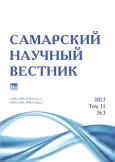Растительный покров и пространственное распределение мелких млекопитающих в условиях лесопарка крупного города (на примере Нижнего Новгорода)
- Авторы: Борякова Е.Е.1
-
Учреждения:
- Национальный исследовательский Нижегородский государственный университет им. Н.И. Лобачевского
- Выпуск: Том 11, № 3 (2022)
- Страницы: 19-24
- Раздел: Биологические науки
- URL: https://journals.rcsi.science/2309-4370/article/view/114875
- DOI: https://doi.org/10.55355/snv2022113101
- ID: 114875
Цитировать
Полный текст
Аннотация
Статья посвящена изучению сопряженности растительного покрова и пространственного распределения микротинных грызунов в условиях лесопарка Нижнего Новгорода. Местом исследования был выбран памятник природы «Дубрава Ботанического сада университета», подверженный частичной антропогенной трансформации. Заложено 5 пробных площадей в различных растительных ассоциациях, представленных липняками. Доминантом на всех пробных площадях является рыжая полевка (73% в целом), кодоминантом – лесная мышь (21%). Желтогорлая мышь отмечена лишь на отдельных пробных площадях. Выявлено, что снижение разнообразия растительных сообществ за счет увеличения степени доминирования отдельных видов не влечет за собой значимых негативных последствий для мелких млекопитающих. Напротив, возможно, именно доминанты растительного покрова создают для микротинных грызунов благоприятный микроклимат. Проведенный PCA-анализ выявил наличие двух факторов, значимых для распределения микротинных грызунов: первый фактор связан с балансом влажности и освещенности, второй – с азотообеспеченностью в сочетании с низкой освещенностью. Отмечено расхождение экологических ниш двух видов мышей – малой лесной и желтогорлой. В отношении проективного покрытия рыжая полевка встречается как при очень высоких (90%), так и при низких (30%) значениях, что подтверждает эврибионтный характер данного вида. Для мышей – желтогорлой и полевой – оптимальные значения проективного покрытия в исследованных сообществах лежат в диапазоне от 70 до 90%, однако желтогорлая мышь может обитать и в ассоциациях с показателем проективного покрытия 40–50%.
Ключевые слова
Полный текст
Открыть статью на сайте журналаОб авторах
Елена Евгеньевна Борякова
Национальный исследовательский Нижегородский государственный университет им. Н.И. Лобачевского
Автор, ответственный за переписку.
Email: boryakova@mail.ru
кандидат биологических наук, доцент кафедры ботаники и зоологии
Россия, г. Нижний НовгородСписок литературы
- Громов В.С. Типы пространственно-этологической структуры популяций грызунов // Зоологический журнал. 2005. Т. 84, № 8. С. 1003–1014.
- Кашкаров Д.Н. Основы экологии животных. М.–Л.: Медгиз. Ленингр. отд-ние, 1938. 600 с.
- Weese A.O. Animal ecology of an Illinois elm-maple forest // Illinois Biological Monographs. 1924. Vol. 9, № 4. P. 351–437.
- Кривоногов Д.М., Заморева Ж.А. Сравнение биоразнообразия мелких млекопитающих смешанных лесов Нижегородской области // Принципы и способы сохранения биоразнообразия: мат-лы всерос. конф. Йошкар-Ола, 2004. С. 96–97.
- Дмитриев А.И., Залозных Д.В., Заморева Ж.А. Мелкие млекопитающие Нижегородской области // Наземные и водные экосистемы. Нижний Новгород, 1999. С. 19–28.
- Puan C.L., Goldizen A.W., Zakaria M., Baxter G.S. Understanding of relationships between ground cover and rat abundances: an integrative approach for management of the oil palm agroecosystem // Crop Protection. Vol. 30, iss. 10. P. 1263–1268. doi: 10.1016/j.cropro.2011.05.025.
- Mattos K., Orrock J. Behavioral consequences of plant invasion: an invasive plant alters rodent antipredator behavior // Behavioral Ecology. International Society for Behavioral Ecology. Vol. 21 (3). P. 556–561.
- Larsen A.L., Homyack J.A., Wigley T.B., Miller D.A., Kalcounis-Rueppell M.C. Altered understory characteristics affect rodent spatial and foraging behaviors and reproduction patterns // Forest Ecology and Management. 2018. Vol. 409. P. 119–128.
- Мининзон И.Л. Флора Нижнего Новгорода. Нижний Новгород: Изд-во ННГУ, 2004. 104 с.
- Лукина Е.В., Баканина Ф.М. Памятники природы города Нижнего Новгорода. Нижний Новгород–Чебоксары: Изд-во «Чувашия», 1997. 142 с.
- Новиков Г.А. Полевые исследования экологии наземных позвоночных животных. М.: Советская наука, 1949. 601 с.
- Карасева Е.В., Телицына А.Ю., Жигальский О.А. Методы изучения грызунов в полевых условиях. М.: Изд-во ЛКИ, 2008. 416 с.
- Боряков И.В., Воротников В.П., Борякова Е.Е. Использование информационных технологий для ординации фитоценариев и обработки геоботанических данных // Ботанический журнал. 2005. Т. 90, № 1. С. 95–104.
- Трухачева Н.В. Математическая статистика в медико-биологических исследованиях с применением пакета Statistica. М.: Гэотар-Медиа, 2012. 384 с.
- Козлов В.И. Динамика численности мышевидных грызунов в Горьковской области за двадцать лет с 1949 по 1969 год // Экология и проблема внутривидовой дифференциации животных Среднего Поволжья. Вып. № 164. Горький: Изд-во ГГУ, 1972. С. 22–28.
- Карасева E.B., Телицына А.Ю., Самойлов Б.Л. Млекопитающие Москвы в прошлом и настоящем. М.: Наука, 1999. 245 с.
- Аристов А.А., Башенина Н.В., Бернштейн А.Д. и др. Европейская рыжая полевка. М.: Наука, 1981. 351 с.
- Лисин С.Р. Относительная численность популяций полевой и лесной мышей и их положение в сообществах грызунов на территории города Горького // Наземные и водные экосистемы: межвуз. сб. / редкол.: В.С. Петров и др. Горький: Изд-во ГГУ, 1985. С. 36–43.
- Речкин А.И. Мелкие млекопитающие – участники циркуляции возбудителей сапронозов на урбанизированных территориях: автореф. дис. … канд. биол. наук: 03.00.16. Нижний Новгород, 1997. 24 с.
- Наумов Н.П. Очерки сравнительной экологии мышевидных грызунов. М.–Л.: Изд-во АН СССР, 1948. 203 с.
- Ellenberg H. Zeigerwerte der Gefäßpflanzen Mitteleuropas // Scripta Geobotanica. 1974. Vol. IX. P. 1–95.
- Лебедева Н.В., Криволуцкий Д.А., Пузаченко Ю.Г. и др. География и мониторинг биоразнообразия: учеб. пособие. М.: Изд-во Научного и учебно-методического центра, 2002. 432 с.
- Уранов А.А., Заугольнова Л.Б., Смирнова О.В. и др. Ценопопуляции растений (развитие и взаимоотношения) / отв. ред. Т.И. Серебрякова. М.: Наука, 1977. 131 с.
- Morales-Díaz S.P., Alvarez-Anorve M.Y., Zamora-Espinoza M.E., Dirzo R., Oyama K., Avila-Cabadilla L.D. Rodent community responses to vegetation and landscape changes in early successional stages of tropical dry forest // Forest Ecology and Management. 2019. Vol. 433. P. 633–644. doi: 10.1016/j.foreco.2018.11.037.
- Szymanski C., Alvarez J.A., Campos C.M., Tabeni M.S. A first assessment of the land management effect on the ecological role of large trees as habitat refuges for desert small mammals // Basic and Applied Ecology. 2020. Vol. 48. P. 136–145.
- Василевич В.И., Пахоруков Н.М., Рубинштейн В.З., Рубинштейн Н.Р. Связь некоторых групп животного населения с растительными группировками // Взаимосвязи комплексов лесных и болотных экосистем средней тайги Приуралья / отв. ред. В.И. Василевич. Л.: Наука. Ленингр. отд-ние, 1980. С. 211–223.
Дополнительные файлы












